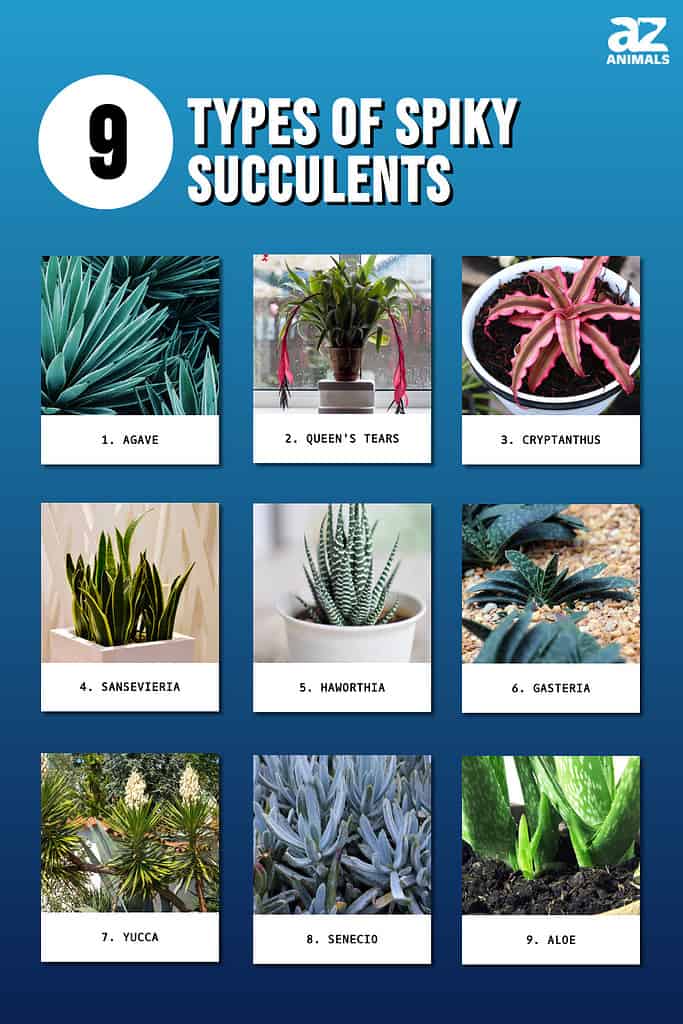
Similar to music, plants can elicit a wealth of different emotions. Some add feelings of serenity and peace. When viewing these plants, it’s as if you planted your favorite smooth jazz album in your garden.
Other plants are bright and cheery. They’re kind of like a catchy pop tune growing right there on your windowsill.
But then there are other varieties of plants that have an edgy, rebellious aura. You might think of them as the horticultural version of a heavy metal song.
Many spiky succulents belong in that last category. Their spikes, points, and sharp edges can have a tough, even menacing, appearance. But let’s face it. Life isn’t all smooth jazz. It’s varied and complex. So why not have that reflected in the plant displays in our homes and gardens?
Here are nine of the most popular spiky succulents, guaranteed to give your plant collection the interesting edge that it might be missing.
1. Agave (Agave spp.)
Agave is among the most well-known spiky succulents, largely because of its use in the food and beverage industries. It is used as a sugar substitute, along with other culinary applications. One specific type, blue agave (Agave azul), is the primary ingredient in tequila. Despite its many uses in kitchens and distilleries, raw agave sap is toxic to both humans and pets.

This field of blue agave plants in Mexico will be used to make tequila.
©javarman/Shutterstock.com
Endemic to arid regions of the Americas and the Caribbean, agaves make wonderful ornamental plants. Most are recommended for Zones 8-9, but there are heat-tolerant varieties recommended up to Zone 11. A relative few are cold-hardy down to Zone 5. It’s important that you research the hardiness zones for your specific agave plant. With nearly 200 species, climate tolerance will vary significantly.
There is also a great diversity of size among agaves. Some remain small, topping out around one foot tall. Others can reach tree-like heights of 20 feet or more.
There are a few agave succulents that aren’t very spiky, such as the foxtail agave (Agave attenuata). Its silver and pale green leaves resemble a fox’s tail and have no spines or teeth.
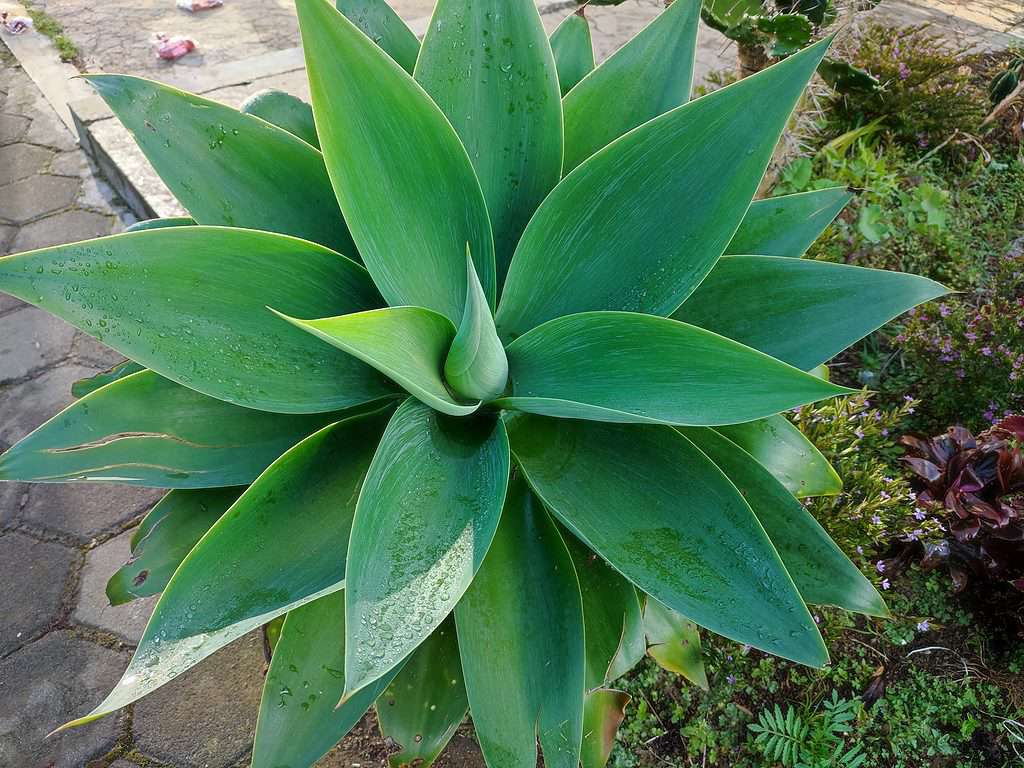
The foxtail agave is a rare agave plant with no spines or teeth.
©Panji.Art/Shutterstock.com
Other species, like the black-spined agave (Agave macroacantha), display a more typical ultra-spiky look.

The black-spined agave lives up to its name, featuring large dark spikes.
©R. Maximiliane/Shutterstock.com
When it comes to spiky agaves (most agave species), caution is the name of the game. As noted earlier, raw agave sap is toxic when swallowed. It’s also a painful skin irritant.
The sharp tip of an agave plant can easily pierce human skin, immediately releasing painful irritants called raphides. This causes immediate pain and a residual soreness that can last for a long time. Wear thick gloves when tending agaves!
2. Queen’s Tears (Billbergia nutans)
Despite its melancholy name, the queen’s tears plant will surely put a smile on your face.
The gray-green foliage has small spines along the edges, making it a spiny succulent. But the royal appearance of the queen’s tears is in full display when the flowers bloom. The pink stems hold clusters of tear-like blooms varying from pink to blue to green.
This member of the bromeliad family is native to Argentina, Brazil, and Uruguay. Its tropical heritage means this plant likes a humid environment. The roots of the queen’s tears are shallow. Most of the plant’s water absorption comes through its leaves, so, unlike many other succulents, you’ll want to mist your queen’s tears regularly. If the leaves begin to display tinges of brown, the air is too dry, and the plant needs more moisture.
The queen’s tears is a sun-loving succulent, so a sunny window is a perfect spot for this plant. Soft morning sun is best. The direct rays of the afternoon sun can potentially damage the blooms.
The queen’s tears plant can also thrive in outdoor gardens if conditions are right. Being a tropical succulent, the plant has no frost tolerance and is recommended for growing in Zones 10-11. If you live in a lower plant hardiness zone, you’ll want to either plant your queen’s tears in a container so you can move it indoors when necessary or grow it as a permanent houseplant.
The queen’s tears is also commonly known as the “friendship plant” because new shoots are produced throughout the year and are easily shared with friends and family.
Bromeliads are generally non-toxic and safe for pets.
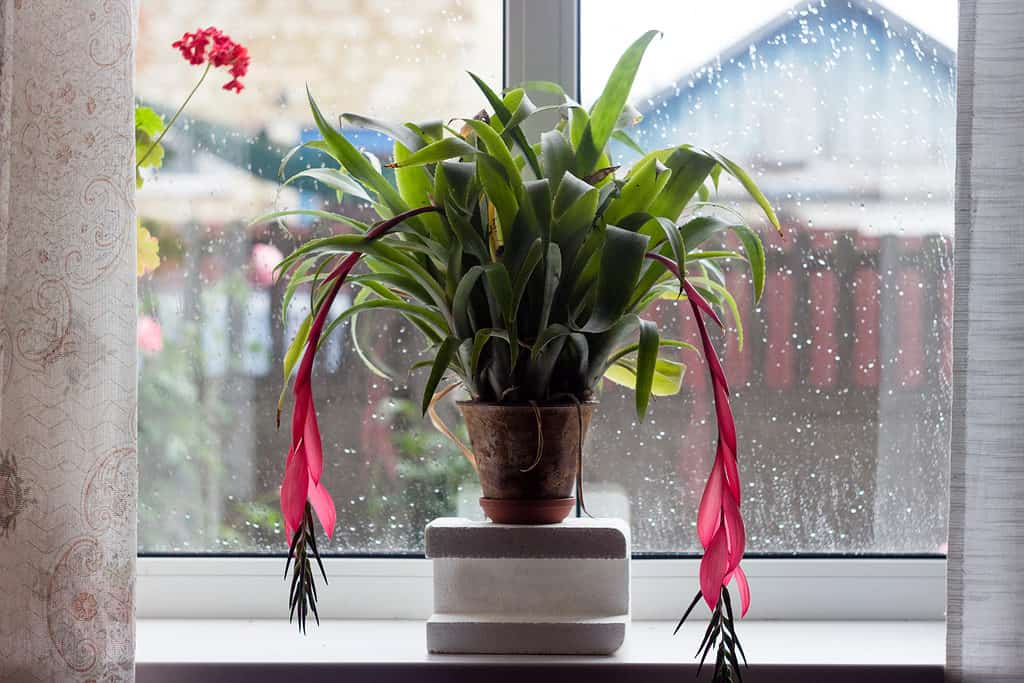
The queen’s tears succulent has small spikes on its leaves and features large, drooping flowers.
©Nikilev/Shutterstock.com
3. Cryptanthus (Cryptanthus spp.)
Another member of the bromeliad family, crypthanus, is a rather large genus of plants with more than 1,200 types and varieties.
Often referred to as earth stars, cryptanthus plants feature leaves that grow in a starlike rosette formation. The leaves can be red, green, or white, depending on the type. In many varieties, the leaves are striped with wavy edges. Short spikes grow along the edges of the leaves. This low-growing plant may not grow very tall but can spread up to two feet wide.
The cryptanthus is native to Brazil and is recommended for growing in Zones 10-11. It is well-suited as a houseplant, so many growers opt for that instead of battling changing outdoor conditions.
Like the queen’s tears, the cryptanthus is a tropical succulent and prefers a humid environment. Therefore, if you are growing your cryptanthus indoors, mist it often. You never want standing water when growing succulents, though. It can lead to fatal root rot.
The cryptanthus, like most bromeliads, is non-toxic.

Cryptanthus are also known as earth stars because of their starlike leaf pattern.
©Andi WG/Shutterstock.com
4. Sansevieria (Sansevieria spp.)
This member of the asparagus family is native to Madagascar and the tropics of West Africa, from Nigeria east to the Congo.
There is a bit of confusion (and debate) in the horticultural world concerning the classification of this plant. Instead of the traditional sansevieria classification, it has been reassigned to the genus dracaena after further DNA testing. This change has been slow to gain acceptance, so plan to see the sansevieria label for the foreseeable future.
Sansevieria plants feature erect leaves with spiny tips. If you’re tight on space, a sansevieria may be just the plant you’re looking for. Unlike creeping or trailing succulents, the sansevieria retains its small footprint, growing tall rather than spreading wide.
These plants are recommended for Zones 9-11 when growing outdoors. Indoor sansevierias prefer bright, indirect light. They are very adaptable to the temperature and humidity of the average home.
There are many varieties of the sansevieria, including the snake plant, Saint George’s sword, African spear, fernwood, sharkfin, and mother-in-law’s tongue (you might want to keep the name of that last one to yourself).
Sansevieria are toxic, so keep them away from pets.

Sansevieria plants grow tall rather than wide, making them great potted plants.
©Aquarius Studio/Shutterstock.com
5. Haworthia (Haworthia spp.)
Haworthia is a genus of small succulent plants, most of which are native to South Africa. A few species are endemic to bordering nations like Mozambique and Namibia.
The fleshy green leaves of haworthias form erect rosettes. The leaves have pointed tips and are usually covered with white bands or warts, giving them even more of a spiky appearance.
There are over 100 species of haworthias, most of which will remain quite small, reaching a maximum height of 3-5 inches. There are a few select species that can grow taller, though.
Hailing from Africa, haworthias are recommended for Zones 9-11 and have no frost tolerance. Temperatures below 40°F can damage or kill these plants.
Their diminutive size makes them ideal plants for small indoor spaces like desks or windowsills.
Like many other spiky succulents, haworthias need bright light but also fare better when shaded from direct afternoon sunlight.
Haworthias are non-toxic for pets.
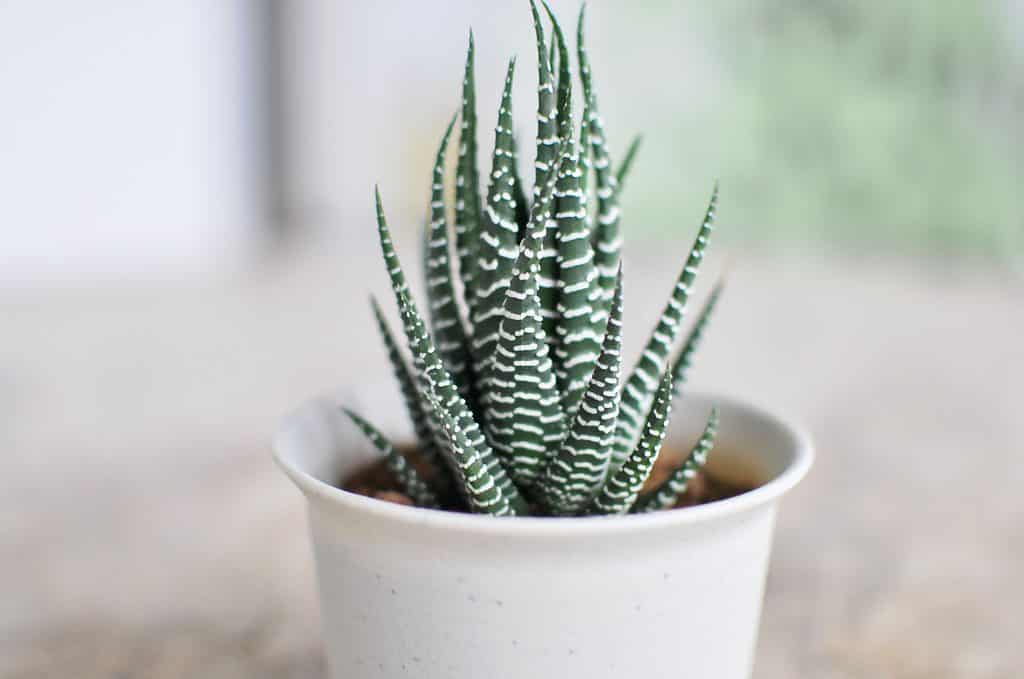
The zebra cactus succulent (
Haworthia fasciata) has erect leaves with a spiky look.
©Daydreamr Digital Studio/Shutterstock.com
6. Gasteria (Gasteria spp.)
Gasteria is a genus of succulents similar to aloes and haworthias. These plants are often referred to as “ox tongues” due to the rough texture of their long leaves. The leaves feature small spikes along the edges and vary in coloration patterns depending on the species. The leaves resemble the shape of a stomach, hence the gastric-themed name. Gasterias also produce curved, tube-like flowers during the winter months.
These succulents are also native to South Africa and are recommended for outdoor growing in Zones 9-11. However, they have no frost tolerance and will die if exposed to cold weather.
Gasterias prefer indirect light but can accept more shaded conditions than many succulents, which makes them wonderful houseplants.
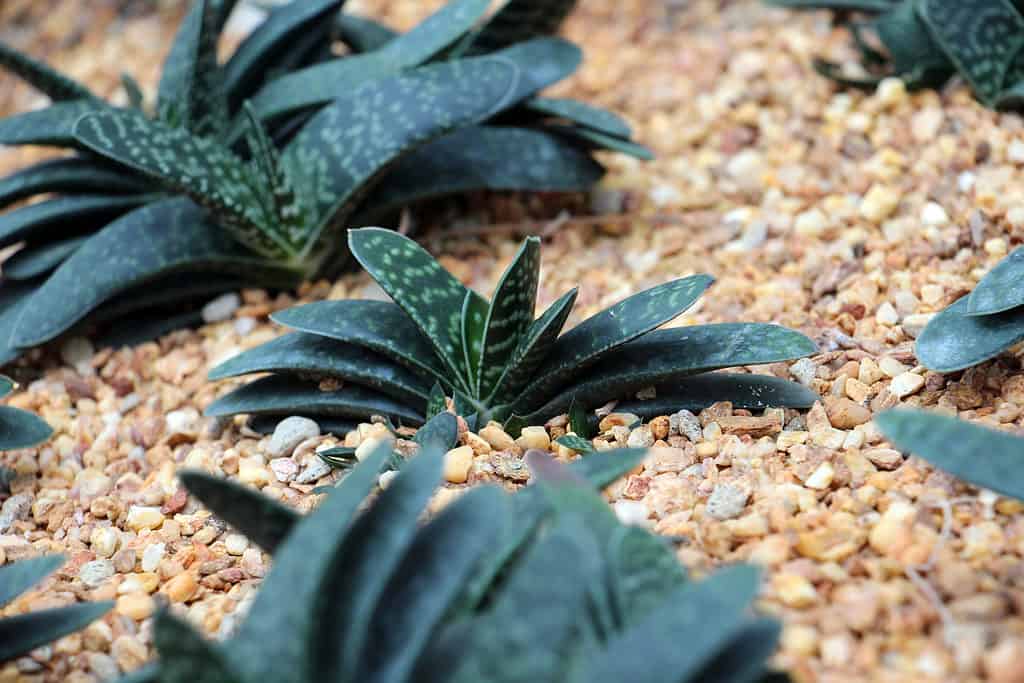
Gasteria plants have rounded leaves with small spikes along the edges.
©My impressions/Shutterstock.com
7. Yucca (Yucca spp.)
Yucca is a genus of around 40 species of plants, shrubs, and trees. Growth rates and sizes vary wildly within the genus, but one thing remains constant among most of these plants: yuccas are some of the toughest, hardiest plants you’ll ever find.
Many spiky succulents are from tropical regions and have no frost tolerance whatsoever. Yuccas are native to the American Southwest, Mexico, and the Caribbean. Not only are they very drought tolerant, but some are also frost tolerant down to 10°F! These spiky plants grow in an absurd range of hardiness zones, recommended from Zone 4 all the way up to Zone 11.

Yucca plants bloom in the summertime, often with white flowers such as these.
©Sean Pavone/Shutterstock.com
Yuccas bloom in the summer, with many varieties displaying white, cream, or bluish-pink flowers atop tall stalks. And when it comes to their foliage, yuccas take the title of “spiky succulent” quite seriously. The leaves are pointed,d and the edges are sharp. As a result, it’s quite easy to be poked or cut by the leaves, so consider that when deciding on placement for your yucca.
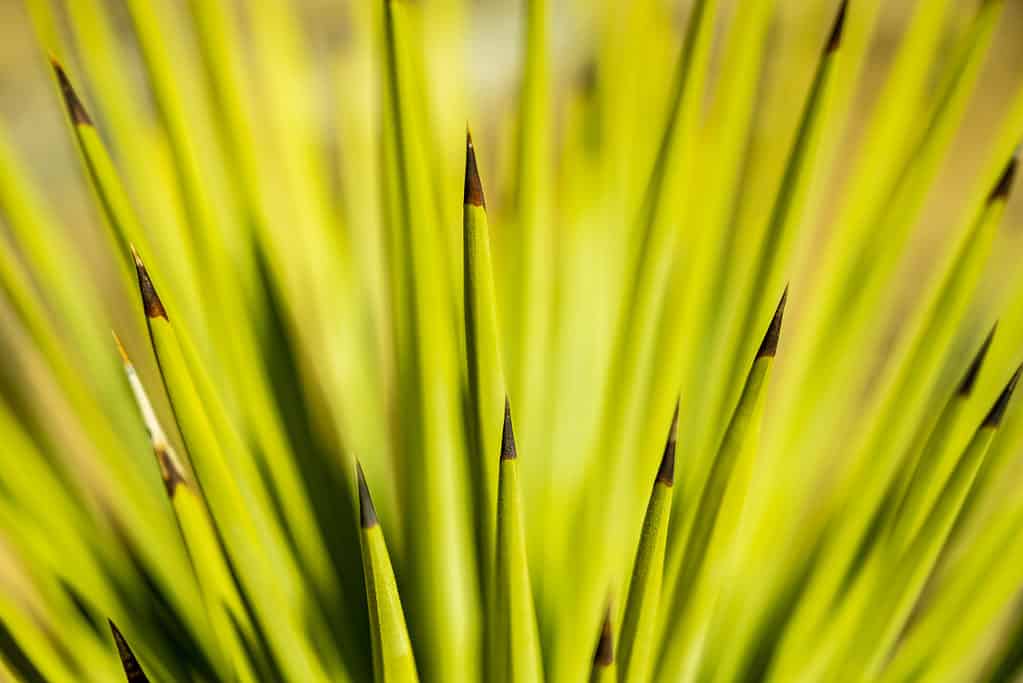
The tips of many yucca plants like this one are needle-sharp!
©iStock.com/kellyvandellen
Speaking of placement, yuccas vary significantly in size depending on the variety. They can range from about a foot tall to upwards of 30 feet, so do your research before deciding to pot that yucca as a houseplant. Also, if you start a yucca as a houseplant, you may need a transition plan to eventually move it outside before it crowds you out of your home. But, again, this varies depending on the specific type of yucca, so be sure to get the facts about your specific plant.
Yucca plants are toxic to pets.
8. Senecio (Senecio spp.)
Senecio is a large genus consisting of over 1,000 species. Only around 100 are commonly used as ornamental plants, though. But even within those 100 species, there is a wide variety of shapes and types of plants.
Senecio succulents are endemic to South Africa and, not surprisingly, are very heat-tolerant and not frost-tolerant. Therefore, senecios are recommended for growing in Zones 9-12.
Some senecios grow as shrubs, and some grow upright, but most are trailing plants that are great for groundcover and look beautiful in hanging baskets.
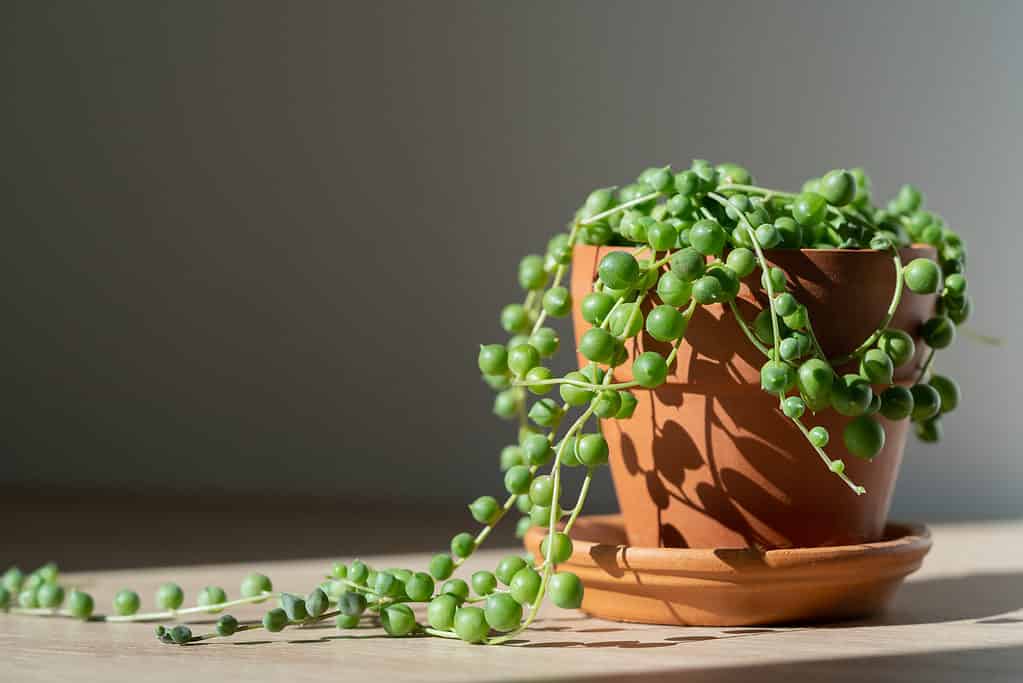
The string of pearls plant has round leaves with very small spiked tips.
©iStock.com/Dima Berlin
Some senecio plants are less spiky than others. For example, the string of pearls (Senecio rowleyanus) is a creeping vine succulent with pearl-shaped leaves with a tiny little spiked tip.
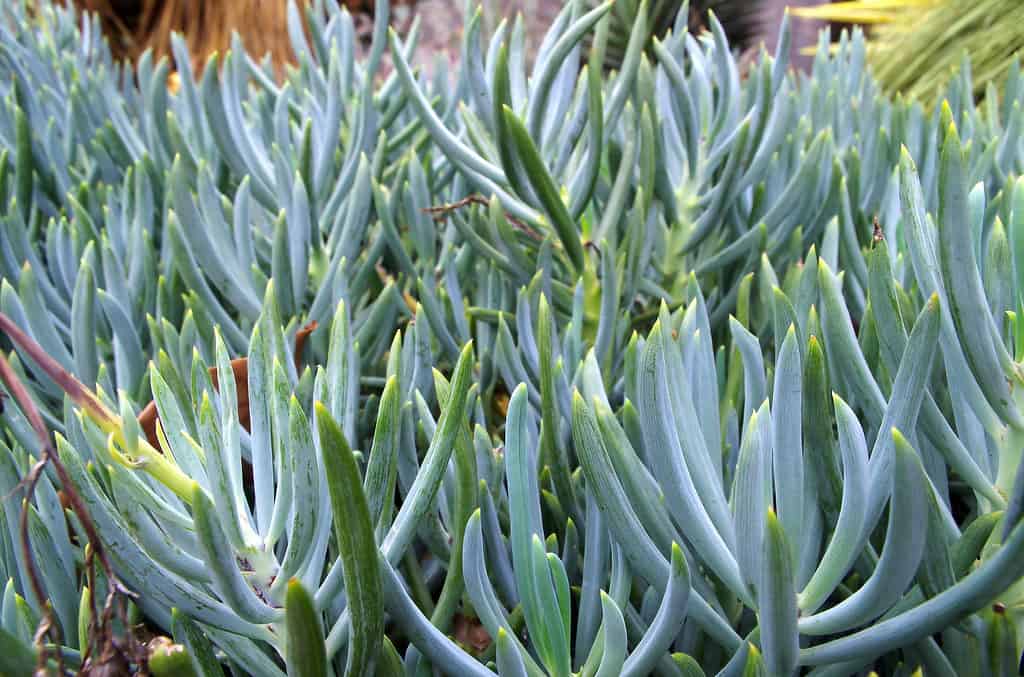
The blue chalksticks plant features pointed leaves with spiked tips.
©nega/Shutterstock.com
On the other hand, the blue chalksticks (Senecio serpens) variety has quite a spiky appearance.
The leaves of senecio succulents can be deep green, bluish-green, or striped. Some are spiky and upright, while others are rounded. One even features leaves shaped like dolphins!
The clusters of flowers also vary depending on the species, appearing in hues of red, white, or yellow.
All senecio species are toxic to humans and pets.
9. Aloe (Aloe spp.)
The most famous of all spiky succulents is undoubtedly the aloe plant. More specifically, the aloe vera plant is famous for its medicinal properties in treating sunburns and minor injuries. But aloe vera is only one of over 500 different types of aloe plants.
Many species remain small and make great potted plants. Others can grow to tree-sized proportions. Color shades also vary in the aloe genus and include hues of green, purple, red, orange, and pink.
Most aloe varieties feature rosettes of fleshy green leaves that are lined with spikes, though some (but not all!) are softer and less painful than other spiky succulents.
Even though the gel of some aloe plants is edible for humans, these succulents are classified as toxic for pets.

Aloe vera, easily the most famous aloe species, grows wonderfully as a potted plant.
©iStock.com/klenova
Care
With such diversity among spiky succulents, creating an exhaustive list of care needs would be impossible. But, while there will always be exceptions, the general principles of succulent care will usually apply.

A well-draining cactus or succulent mix is perfect for most spiky succulents.
©iStock.com/naramit
Most spiky succulents will thrive in rocky or sandy soil. A cactus or succulent mix is usually good for potted plants, or you can mix your own using potting soil and perlite. Make sure the container has adequate drainage holes. Terracotta pots are a good choice since they wick away excess moisture from the soil.
Most succulents need bright sunlight, but many don’t tolerate direct afternoon sun, especially in warmer climates.
Spiky succulents are generally susceptible to pests like most other succulents, including aphids, mealybugs, and scale. If these pests are present, dip a cotton swab in rubbing alcohol and apply it directly to the insects. For larger infestations, spraying insecticidal soap on the plants can rid them of these destructive pests.
Most importantly, do not overwater your succulent plants. Some require more water than others (as noted with some of the tropical succulents discussed earlier), but virtually all of them can be damaged or killed from overwatering.

Spiky succulents, such as this aloe plant, can add an edginess to your home or garden.
©Lara Field Gomersall/Shutterstock.com
Spiky succulents are growing in popularity because, like most succulents, they are usually easy to care for and quite forgiving of neglect. In addition to their ease of care, they also add a little bit of sass, attitude, and edginess to a plant collection. If that’s what you’re looking for, a spiky succulent might be the perfect plant for you.
Summary of 9 Types of Spiky Succulents
| # | Succulent | Interesting Fact |
|---|---|---|
| 1 | Agave | Used to make tequila |
| 2 | Queen’s Tears | Stems hold clusters of pink tear-like flowers |
| 3 | Cryptanthus | Grows up to 2 feet wide |
| 4 | Sansevieria | Also known as “Mother-in-laws-tongue” |
| 5 | Haworthia | Small striped plants great for desktops |
| 6 | Gasteria | Also known as “Ox Tongues” |
| 7 | Yucca | One of the toughest, hardiest plants |
| 8 | Senecio | Toxic to humans and pets |
| 9 | Aloe | Known for its medicinal properties |
The photo featured at the top of this post is © Willem Van Zyl/Shutterstock.com
Thank you for reading! Have some feedback for us? Contact the AZ Animals editorial team.







